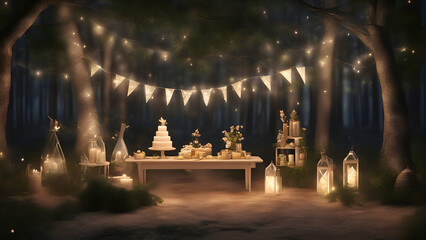Crafting Experiences: Exploring the Essence of Event Design and Its Impact
Event Design Dallas encompasses the entire visual presentation of an event. This includes everything from decor to venue layouts to lighting.
Start by understanding your event’s objectives and attendees’ specific needs. This can be done through data analysis from previous events or surveying potential attendees.
Space
 The event space is the physical environment within which an event takes place. It includes the venue, layout, furniture and equipment. The overall look and feel of the space should reflect the event’s style, theme and message. This can be achieved through decor, signage, and a color scheme.
The event space is the physical environment within which an event takes place. It includes the venue, layout, furniture and equipment. The overall look and feel of the space should reflect the event’s style, theme and message. This can be achieved through decor, signage, and a color scheme.
Event spaces should also be functional. They should accommodate various activities and be equipped with the necessary technology. For example, conference rooms should have the capacity for speakers, podiums and AV equipment. Other areas should be available for networking and exhibitor booths. Finally, event planners should plan for emergency situations such as evacuations and power outages.
A good design uses space to highlight focal points and create an inviting atmosphere. For example, a tall tree or a stage can be used as a centerpiece for an event. Similarly, lighting can be used to draw attention to the main attraction of an event.
The use of lines is another crucial aspect of event design. For example, horizontal lines can be used to elongate a room and vertical lines can be used to make a room feel more intimate.
It’s important to strike a balance between open space and cosy space. Too much empty space can make an event feel sterile and soulless, but not enough space can leave attendees feeling uncomfortable and cramped. Depending on the complexity of the build and how much equipment is required, the event design process can take up to a year to complete.
Lines
The way that lines are used at an event can make the space feel intimate or grand, depending on what the planner wants to accomplish. Horizontal lines, like the dotted pattern on a rug, can bring a sense of balance to an event, while vertical lines, such as a sloping staircase, can add depth to a venue.
Lines are also important when it comes to proportions. For instance, a long line at an event can be an eyesore, but if it’s a short wait, guests may not mind. This is why it’s important for planners to think about how guests will experience an event and what kind of queues might be necessary, so that attendees don’t get grouchy over waiting too long.
Event design is the process by which a designer creates a visual representation of an event, choosing a theme and aesthetic elements to generate the desired atmosphere and emotion. Event designers can work with planners to create a fully-fledged event, or offer their services separately depending on their specialties and skill sets. Some designers started as florists who decided to expand their business, while others have transitioned from interior or set design. Regardless of their background, event designers are all dedicated to creating unforgettable experiences for their clients. By leveraging their creative and technical skills, event designers can ensure that the goals of their clients are both met and exceeded.
Texture
Event design is a form of art that transforms a venue into an inspiring place that stimulates the senses. This is not just about aesthetics, however – it’s about bringing the event to life and facilitating greater attendee engagement.
Like the outfit you choose for a job interview, the decor at an event communicates a lot without saying a word. It acts as a silent spokesperson for the brand, and it can help create an immersive experience that etches the brand’s visual identity into attendees’ memories.
Texture is an important event design element that can have a big impact on the overall mood and feel of a space. It can be used to make a space feel cozy and homey, or it can be used to create an ethereal backdrop. It’s also a great way to add contrast, and it can be used to create patterns that are bold or subtle.
Color is another essential element that can have a huge impact on the overall feel of a space. It can be incorporated into key event elements such as decorations, lighting and printed materials like menus, but it’s important not to go overboard – color should accent a space rather than overwhelm it. Playing with different hues of your core colors can add interest to your aesthetic while maintaining a cohesive look. It’s also a great way of highlighting key shapes and lines in your design.
Lighting
Lighting plays a critical role in the overall aesthetics of an event. It can set a romantic and cozy mood or give the room a lively, energetic feel. When paired with sound and video, lighting can truly captivate the audience.
For example, if the event is a formal gala or techy product launch, using different color lighting can set the tone. For instance, warm colors evoke a sense of intimacy and comfort while bright, vibrant colors evoke excitement and energy.
Incorporate patterns to add a unique touch to the design. Patterns can be incorporated in the form of patterned flooring, wallpaper, and linens to create an engaging design. Incorporating these patterns can also help to draw attention to a focal point in the space, such as a speaker or performer.
A well-designed lighting scheme can also highlight key areas in the venue through uplighters, projecting images on dance floors (gobo lighting) and incorporating interchangeable color with LED lighting. In addition, event designers can experiment with a variety of lighting techniques that are unique to the event such as projection mapping and pixel tube lights. These can transform surfaces into mesmerizing visual displays that appear to move on their own. This can be especially effective for bringing a theme to life or creating a sense of magic.
Colors
Colors are the biggest visual component of any event and are a powerful tool for creating an immersive experience. They invoke emotional responses and can be used to convey a theme, brand, or message. A careful consideration of how colors work with lighting and the venue is essential for creating a cohesive design.
Different hues can make people feel a variety of ways, from excitement and energy to calmness and trust. The right palette will depend on the type of event, its goals, and the audience. For example, a conference that wants to foster creativity should use bold oranges and greens while an evening of celebration may be best served by darker shades like black.
A good way to test the impact of a visual design, including its colors, is to conduct a user study. This can include open-ended questions to encourage participants to discuss their reactions or controlled tasks that allow them to select descriptors from a list. According to Nielsen Norman Group, this is the most effective way to test the effectiveness of a design.
In addition to establishing an aesthetic, event designers must consider the impact of color on accessibility. For example, using high-contrast color combinations helps ensure that important information is clearly visible to attendees with mild visual impairments. It is also important to avoid certain combinations, such as red and green, which can confuse people who are colorblind.
Furniture and Equipment
Event design is the process of planning and implementing creative visual displays, signage, and other elements to create a meaningful experience for attendees. This includes the use of stage backdrops, lighting, and seating that are matched to your audience and event goals. It also involves creating an environment that encourages communication and promotes your brand.
The first step in the event design process is understanding your audience and the goals of your event. This will help you define a theme that will guide all design decisions throughout the planning process. This will help you create a consistent, unified experience for your audience and ensure that all design elements align with the theme.
Patterns are another element that can be used to add depth and interest to an event space. Whether they’re stripes, animal prints, or geometric patterns, these can be used to elevate the style of an event while still remaining aligned with your overall theme and goals.
Once you have a clear understanding of your venue and its features, the next step in the event design process is mapping out your layout. This will include creating a plan for where all furniture and equipment should be placed, as well as how it will fit within your venue’s dimensions. This will help you ensure that there is enough positive (furnished) and negative (unfurnished) space so that your event doesn’t feel crowded or empty.
